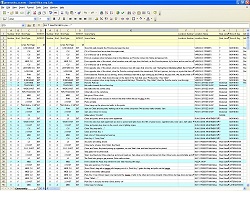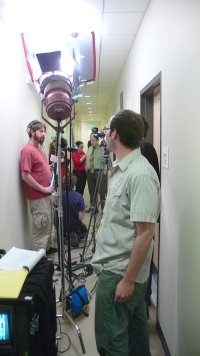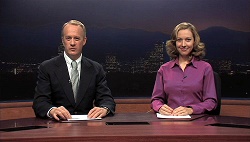Introduction
Thinking about making an Indie film, or just want to know what’s involved? Last August, we started our adventure with Part I – The Writing. In the current article, you will learn about Production, and that begins with Pre-production.
If there’s one lesson that we’ve learned from the making of Generosity, it’s “don’t skimp on Pre-production”. I’m sure there are lots of books on movie-making that tell you this, but honestly, who has time to read them?
Pre-production is any and all planning: shot list, schedule, story boards, wardrobe and props, securing locations, approximately one million things.
The typical wisdom regarding pre-production is to story board each of your shots. A story board is drawing of what you want the shot to look like. For a movie like Generosity, a two hour feature film, that would be something like six hundred drawings. Obviously we didn’t do this. For myself, it was from watching DVDs with commentaries that I first learned that story boarding is not as prevalent as we had been led to believe. For some shots we did think it necessary, and Ray drew up about six story boards for those particular shots. It soon became clear, however, that for most shots, much would depend on the location – which wasn’t always nailed down yet. For other shots, it was either so simple (as in close-up) or clear enough in our minds that there was not much to be gained from a story board.
What we did do was create a giant (and I don’t use the term lightly) spreadsheet to plan the shots. This is something that I haven’t seen in the film production books that I’ve read (er, skimmed), but there are some script writing/movie production software packages that are alleged to perform a similar function. The spreadsheet columns start at ‘A’ and goes to ‘EQ’. There are 121 columns, and 590 rows – basically one row per (planned) shot. Click on the photo to see the mid-sized version. Then, there is a small blue box with arrows on it in the bottom right corner that you will have to click to bring it to its full size.
Across the top the columns are titled: Number, Shot, Shot Type, INT/EXT, Scene Name, Time of Day, Props . . . it goes on and on. Columns P-DX are character names. If the character ‘Punk Boy #1’ is to appear in scene 6, shot D, the box for that column and row will have a number, the number being the number of lines for the character in that scene. This information had to be entered manually from the script, and once it was there, we used the features of Open Office’s Calc (a free spreadsheet program that functions much the same as Microsoft’s Excel) to derive other columns such as column EF, which listed all of the actors needed for a given scene.
Column K is labeled ‘props’. If the script calls for a character to have cigarettes, it’s listed here. Column L is wardrobe notes. All of this – the actors, props, and location are what is needed to plan a day of shooting. This was especially handy in working around the complicated schedules of our actors and sometimes the crew. Our principal actors all had other jobs and commitments, ranging from school to radio commercials to a musical based on Walmart. If a given location was no longer available on a particular day, we could quickly scan the spreadsheet for other scenes where we could use the actors that we had available at that time. Of course, any changes had ramifications for future schedules, and re-scheduling eventually became a bit of a sore spot for some of the actors.
We did find some freeware script writing software that presumably will someday be able to handle many of these spreadsheet tasks automatically – you should be able to ‘tag’ items in the script as prop items etc., and the rest could be automated. But, that software was not at that stage when we started this project. Iit had a word processor that automatically formatted in movie script layout, but that was about it. In looking at their website now, they seem to have progressed quite a bit, and many of the tagging features seem to be in place.
So, the script was written with a much older software package, ‘vi’. This is among the oldest text editors known to man, but still a favorite for many computer programmers. List any feature available in Microsoft Word (spell check, word count, comments, formatting of text) and you can rest assured that vi does not have it. It’s a simple text editor, and for programming that has many advantages. For spell checking and printing we did have to finally paste the movie in to Open Office ‘Writer’. I’ve got a suspicion that Generosity may be the only full length movie ever written in ‘vi’.
Did I say, “Location”?
If a movie is to be shot on location, as Generosity was, securing locations is the biggest, badest part of pre-production. Our list of locations: coffee shop, restaurant, Eric’s office, Boss’s office, hallway, medical clinic, is yet another list that goes on and on. The big budget solution is to hire a locations manager, someone to find suitable locations and secure the rights to shoot there. This was the contribution of the Boulder Film Commissions office – they recommended a person we could hire for this. His fee was 3x the initial budget and so was quickly forgotten. This was about the extent of the contribution from the Boulder Film Commission until the last week of shooting, when we still hadn’t secured a location to be a hospfital exterior. A quick phone call to the commission and they were able to suggest and arrange the Boulder Justice Center as a stand-in. In the meantime though, Ray worked on his own and with our principal crew chiefs Kurt Van Ulmer and Lily Duke to get the rights for the locations we wanted. Unfortunately, the work of securing locations turned out to be a major drag on everyone’s time even as the shooting was getting underway. In between scenes, instead of planning the shots, Ray and myself would be dragged into making decisions about locations needed in the near future. At this point, there was no other way to do it. Having the locations up front would have allowed for more planning (story boarding) which would have enabled us to send crew to prepare locations for shooting before the camera and actors were on site, and certainly would have made the movie set a bit less stressful. Live and learn.
Of course for our movie about homeless life, the streets themselves were the most important location. We were lucky to get the approval to shoot from the City of Boulder. Having had a bad experience with the last movie – a major Hollywood production staring Anthony Hopkins, a movie which abandoned pfroduction after having closed major streets and the pedestrian mall in Boulder – they were not anxious to grant permission to any more movie productions. It wasn’t hard to convince them that we were nothing like a major Hollywood production but more importantly I think, we were a Boulder production – local. Ellen Cunningham, Events Manager for the City of Boulder, was the person kind enough to sign the papers to let us proceed. She also kept a close eye on use at various times throughout the shoot. We’re proud to say that the only things Ellen caught us at were occupying a portion of a fire lane with our equipment (on that same pedestrian mall) and blocking traffic on a street without permission and without the police there. Apparently, if you block a major street without at least the appearance of authority (our crew members exuded many things, but authority was not one of them), you will trigger complaint calls at the rate of one per minute. Our on-and-off blocking of a major downtown Boulder street over a fifteen minute period triggered 15 complaint calls.
We had tremendous luck with some other locations as well. A couple of friends were enthusiastic about loaning their houses for some interior shots. Your friends would probably do the same, but here’s some advice: If someone wants to use your house for a movie shoot, just say, “No”. More on that in another article. The really tremendous luck came into play for two other locations. Ray’s former employer (which will remain nameless to protect the guilty) allowed us access to their interiors for extensive office shots. There was the initial “No” (just say, “No”) to our request, probably for the usual ‘liability reasons’ but an appeal to higher-ups resulted in a most gracious override. We came in on weekends and were required to have a currently-employed chaperone at all times. Arranging this was easy because people were curious to see what went on during a movie shoot. Our other stroke of luck was access to the newly constructed Atlas Center on the University of Colorado main campus in Boulder. I still can’t get over this. If the city of Boulder is a tough nut to crack, the university is a ball-bearing. It was only through the connection of one of our crew members who currently attends the university that we were able to get in. If you want a set that looks like a TV studio, there’s nothing better than a TV studio.
We did most of our shooting in the hallway outside the amazing soundstage, but there was a transformer buzz from a power room that gave our sound guy fits.
Our other major use of technology was in putting out the call for actors and in viewing the results. Casting agencies make their actor’s profiles available online, and through e-mail, they can get their actors to auditions in great numbers. Craigslist is handy for the rest (extras and minor parts on short notice). For the principal actors, we held two days of auditions in Boulder. Ray compiled the results and made the videos available online so that I could see them from Portland. With a still camera, and from a distance away, it was difficult to see what sort of nuance the actors were bringing to the audition (if any). Still I chipped in what opinions I could (I never seem to be lacking in an opinion) and Ray chose his actors.
Here began one of my major lessons in this project: a script is interpreted. All the time we were writing the script, I think I had one vision of the characters in my head while Ray had another. When the actors came to the set, they had their own interpretation, often bringing more life to the lines than I knew were there. Movie making is a collaborative affair.
Next Up: Adventures on Location




